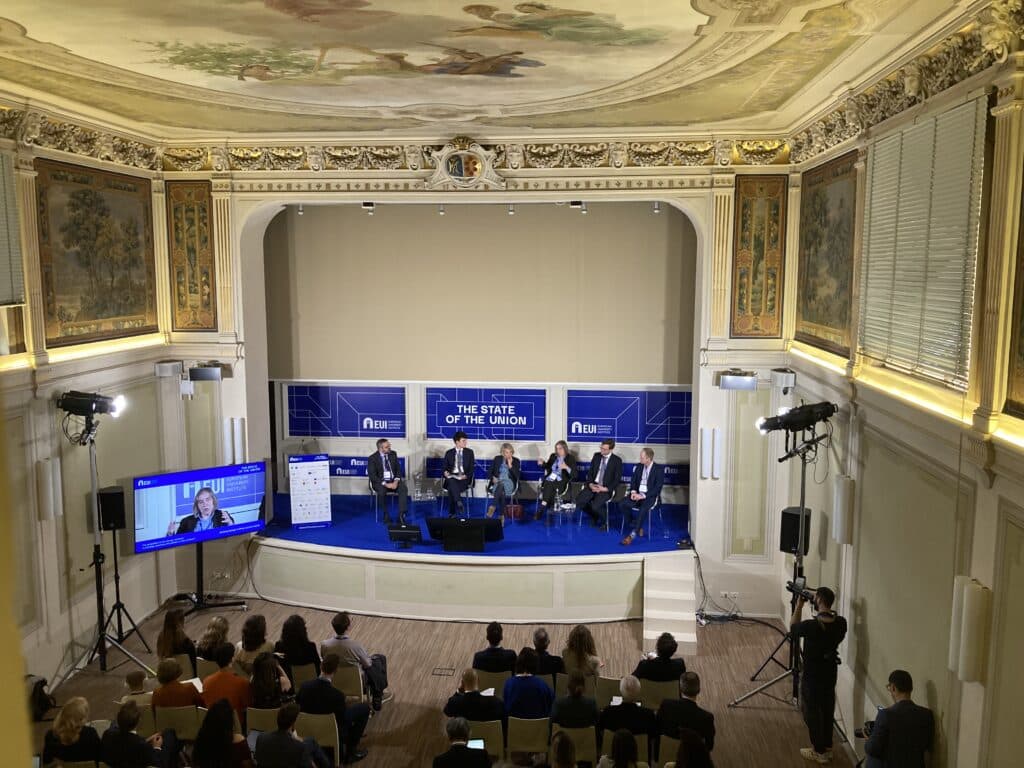The European Commission’s proposed Climate, Energy and Environmental State aid guidelines: where are we heading?
Highlights from the online event: How green is state aid control?
On Thursday, 1 July 2021, the FSR Energy Union Law area hosted a joint event with the Centre of European Law at King’s College London on the topic of the European Commission’s proposed Climate, Energy and Environmental State aid guidelines, which are currently subject to public consulation.
Watch the recording:
Main takeaways from the event
The event was chaired by Andrea Biondi (King’s College London), who commenced by welcoming participants and by introducing the speakers: Nicola Pesaresi (Head of Unit, State aid I, Directorate for Energy and Environment, DG Competition, European Commission); Alejandro Donnay (Deputy Head of Unit, State aid I, Directorate for Energy and Environment, DG Competition, European Commission); Nicole Robins (Partner, Oxera); and Leigh Hancher (FSR).
Mr Pesaresi gave the first presentation. He stated that the name change from the Energy and Environmental State aid guidelines (EEAG) to the Climate, Energy and Environmental State aid guidelines (CEEAG) was not just a “rebranding” exercise but reflected the fact that the CEEAG proposal broadens the remit of the guidelines to new areas and fields that include fundamental parts of Member States’ economic policy. While the EEAG had already provided a framework to address several of what are now considered European Green Deal priorities, the fitness check carried out in 2019 showed that there was need for a more comprehensive redesign. This revision process involved stakeholder consultations, an external support study and case practice review.
The main building blocks of the CEEAG represent an enlargement of scope, extending the guidelines to cover new areas and particularly new technologies, as well as incorporating more flexibility. The latter is particularly important since there will be no “one size fits all” solution for Member States to contribute to the achievement of Green Deal objectives. The new guidelines will thus provide principles and guidance for assessing (technologically) novel measures. Mr Pesaresi stressed that this new flexibility will need to be accompanied by more comprehensive safeguards. Overall, the revisions aim to bring about a closer alignment between the guidelines and existing (and forthcoming) sectoral legislation in the environmental and energy fields.
The new guidelines aim to facilitate to a maximum extent so-called “green” measures, that is those that are compliant with the EU’s 2030-2050 decarbonisation trajectory. “Grey” measures, such as new natural gas pipelines, will also need to be compatible with this trajectory to receive aid, for example by being hydrogen-ready. Support for emissions-intensive “brown” measures, meanwhile, will be phased out.
In his ensuing intervention, Mr Donnay provided further details on the safeguards that will be needed to ensure the proper application of the CEEAG, especially considering that the new guidelines will no longer be technology-specific. A key part of this effort will be enhanced transparency and public participation requirements for large schemes. States will need to be transparent regarding the contribution of projects to environmental protection. The CEEAG also have the objective of expanding the competitive bidding process to arrive at the most efficient support. Mr Donnay emphasised the CEEAG’s commitment to ensure a “greening” of Member States’ security of energy supply. After the conclusion of the ongoing consultations on the draft guidelines, it is the Commission’s intention have the CEEAG adopted before the end of 2021.
Subsequently, Ms Robins commented on the presentation by the Commission representatives and the CEEAG more broadly, stressing the important role that in-depth economic and financial analysis will play under the proposed new regime. Given the long economic lifetime of energy infrastructure, sophisticated models with a high level of granularity will be needed to take into consideration a changing European energy mix and the impact of aid on innovation. Modelling robust counterfactual scenarios will be a particular challenge. However, detailed economic and financial analysis will also be important ex post under the new guidelines, which call for a verification of whether the projected objectives and impact of a given project have been achieved. The more prominent role of ex-post clawback mechanisms in particular will necessitate such an analysis. Ms Robins also highlighted the need for careful design of auctions, which will play a more important role given the CEEAG’s emphasis on expanding the competitive bidding process. This is because poor auction design could lead to a risk of strategic bidding and thus to a situation where the aid is not limited to the amount necessary to obtain the objectives and benefits of a project. This links to broader questions about what constitutes a reasonable level of expectations for future profits, an assessment that is complicated by factors such as new technologies and changing risk profiles of certain energy installations.
In her comment, Prof. Hancher focused on the extensive consulation requirement foreseen under the CEEAG. This requirement, according to Prof. Hancher, reflects the sensitivity of this policy area and the difficulty of keeping all stakeholders on board without such consulation obligations. However, since the consulation requirements are rather minimal at this point, it remains unclear how these will fit in more broadly with the compatibility assessment and procedure. This poses questions as to how effective consultation will be ensured (and indeed, what criteria will be used to assess such effectiveness). The proposal also leaves open the importance that the compliance with consulation requirements will have for the notification procedure. Prof. Hancher further agreed with Ms Robins in stressing the importance of ex-post clawback mechanisms. In addition to an issue for financial and economic analysis, this is also an important question for governance. How, for instance, will the public be kept informed about whether objectives have been met? Prof. Hancher suggested that such questions could be taken into account in the redesign of the Regulation on the Governance of the Energy Union and Climate Action.
Prof. Hancher further argued that it remained to be seen whether the CEEAG’s green security of supply initiatives would be sufficient to prevent the development of grey and brown projects, given that the Court of Justice has tended to be sensitive to Member States’ security of supply concerns, a position that could be strengthened by the Court’s imminent ruling in Case C-848/19 P – Germany v Poland (the OPAL case).
After a lively Q&A session, Prof. Biondi concluded the event by thanking all speakers and participants for their engagement and contributions and looked forward to future collaborations between the FSR and the Centre of European Law at King’s College London.






